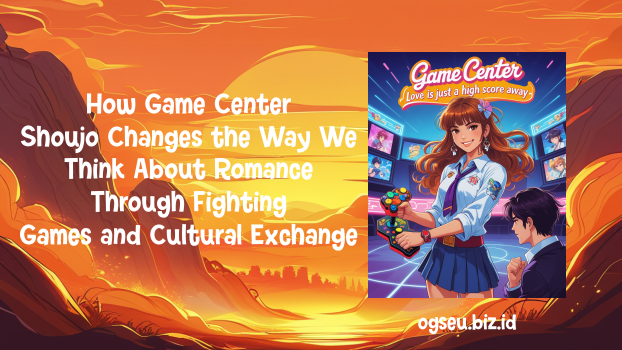How Game Center Shoujo Changes the Way We Think About Romance Through Fighting Games and Cultural Exchange – Readers of romance comics are used to certain clichés, such the dramatic confession under a cherry blossom tree, the fated meeting on the way to school, and the classic love triangle full of misunderstandings. But every once in a while, a series comes out that breaks all the rules and tells a tale that is so original and wholesome that it draws in a whole new group of fans. Yasunobu Yamauchi’s Game Center Shoujo to Ibunka Kouryuu (The Girl at the Game Center and Cultural Exchange) is one such gem. It’s a manga that uses the subtle language of button presses and joystick movements instead of big love gestures.
The main idea is deceptively basic at its foundation. Onizuka is a quiet Japanese high school student who doesn’t get along with other people very well. His one true love is a made-up fighting game called “Final Bout.” He spends his afternoons at the local arcade, where he works on his abilities, but a strange player with an in-game handle always beats him, practically without trying. This adversary is a ghost, a quiet genius who plays with such grace and accuracy that Onizuka is amazed. The main hook of the story is that he finds out his enemy is not a tough arcade veteran, but Lily Baker, a lovely, shy foreign girl from his school.
The biggest problem between them right now isn’t their competition; it’s language. Onizuka doesn’t speak English, and Lily doesn’t speak much Japanese. This is where the entire title of the manga, The Girl at the Game Center and Cultural Exchange, really comes to life. Their friendship is based on a shared enthusiasm that goes beyond language and culture. The arcade is their safe place, and the fighting game is their common language.
Contents
The Arcade as a Language for Everyone
Yamauchi skillfully turns the loud, neon-lit pandemonium of a Japanese game center into a holy place where people can interact. The “Final Bout” cabinet is more than just a machine for Onizuka and Lily; it’s a place to talk. A match is a conversation. Their first polite gesture is the delicate dance of “footsies,” which is the back-and-forth movement to regulate space. A well-timed block or parry is a smart way to respond. A devastating combo is a strong message. A “GG” (Good Game) nod after a match is a symbol of respect between players.
They learn about each other’s personalities through their actions in ways that words might not show. Onizuka’s writing is honest and simple. It can be predictable at times, but it’s always sincere. Lily is graceful, precise, and quick to react. She can practically read her opponent’s mind. Her patient, punishing playstyle shows that she is quiet and observant. Their contests are more than just games; they are a deep, non-verbal way to talk to each other. They are getting to know each other’s rhythms, guessing what the other person is thinking, and growing to deeply respect each other’s abilities. The main point of the manga is that you don’t always need a shared language to understand someone; you need a common ground.
Goodness in a World of Low-Stakes Happiness
Game Center Shoujo is different from other games since it always tries to be good. The story is a comfort for people who are tired of fake drama. There are no bad rivals, no fake disagreements meant to break up the leads, and no over-the-top emotional pain. The stakes are low and very personal: Can Onizuka finally win a match? Will they be able to eat a snack together after school? Will he be brave enough to say “Hello”?
The “romance” grows slowly and steadily, like a flower opening. There are small, quiet times when it happens, like when Onizuka buys Lily her favorite canned drink from the vending machine, when they stroll home in comfortable calm, or when Lily’s lips curl into a slight smile after a really intense match. They love each other because they respect each other and have fun together. The accompanying people, like the nice and watchful arcade manager, only help this new relationship grow by being good guardians of their innocent interactions.
The manga can focus completely on the purity of their love because there isn’t any traditional conflict. It’s a story about the deep, uncomplicated joy of discovering someone who understands your specialized interest and can be a part of your life without you having to explain anything.
The “Ibunka Kouryuu” (Cultural Exchange) is more than just a game.
The fighting game is the main way they talk to each other, but the manga slowly and brilliantly brings their conversations into the real world. This is when the “Ibunka Kouryuu” part really shines. At first, Lily is a mystery, but as she spends time with Onizuka, she learns more about Japanese culture. She finds happiness in a certain kind of ice cream or a local snack.
On the other hand, Onizuka tries clumsily and endearingly to bridge the language divide. He often fails comically when he tries to utilize translation apps or acquire a few English phrases, but these failures are a big part of his personal progress. He is leaving the arcade, where he feels safe, and trying to connect with Lily on her terms. These little cultural exchanges are huge in the context of their relationship. They show that the bond formed in the digital world of “Final Bout” is strong enough to last in the complicated world of real life. The game was the link between them, but their universe is growing beyond it.
To sum up, Game Center Shoujo to Ibunka Kouryuu is a masterclass in how to tell a tale without being too obvious. It shows that a good romance doesn’t need big speeches or lots of drama. Yasunobu Yamauchi has written a story that is both very distinct and very accessible by setting it in the unique subculture of arcade fighting games. It’s proof that shared passion is the best way to communicate, able to establish bridges when words fail. For gamers, it’s a love tribute to arcade culture. It’s a refreshing, honest, and joyful story for anyone who like romance. But for everyone, it’s a lovely reminder that the most significant connections may happen in the most unexpected places, one quarter and one “good game” at a time.
Read also : An In-Depth Guide to Playing Planetarian




